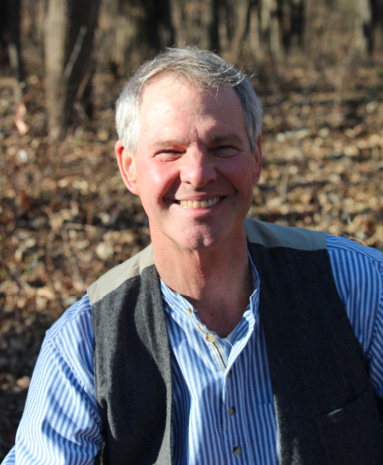- Charles E. Connerly, Green, Fair and Prosperous: Paths To a Sustainable Iowa. Iowa City: University of Iowa Press, 2020.
- Greg Hoch, To Find a Pasqueflower: A Story of the Tallgrass Prairie. Iowa City: University of Iowa Press, 2022.
- Robert Michael Morrissey, People of the Ecotone: Environment and Indigenous Power at the Center of Early America. Seattle: University of Washington Press, 2022.
- Cornelia F. Mutel (ed.), Tending Iowa’s Land: Pathways to a Sustainable Future. Iowa City: University of Iowa Press, 2022.
The last three years have seen the publication of several excellent books about the tallgrass prairie. Here are a few of them that I would like to call to our readers’ attention.
How well do we know the Tallgrass Prairie Region?
Sadly—but undeniably—one of the most trenchant observations one can make about the tallgrass prairie biome today is that almost all of it has been destroyed. The usual statistic cited for Iowa, which once had the highest percentage of its land in tallgrass prairie of any state (about 80 percent), is that less than one-tenth of one percent of the original prairie remains. The figure varies somewhat for the other prairie states, but the bottom line is the same: most of it is gone.
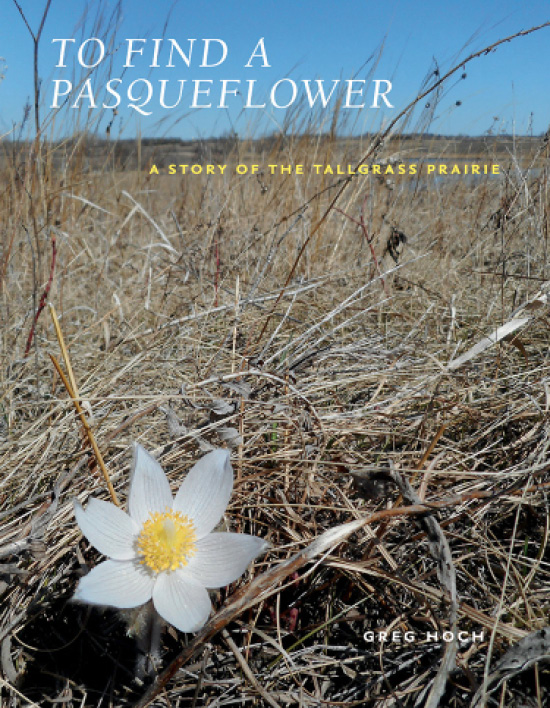
Photo courtesy of the University of Iowa Press
Based on the abundant facts and insights that are crammed into the 235 pages of Greg Hoch’s To Find a Pasqueflower: A Story of the Tallgrass Prairie, and on the nearly 500 references in his bibliography, I venture to say that Hoch, a prairie ecologist with the Minnesota Department of Natural Resources, knows the tallgrass prairie as well as just about anyone. Yet one of the things that struck me in reading his book is how often Hoch points out how much we really do not know about the prairie, and how much of what we think we know is wrong. For instance, the conventional wisdom was that the tallgrass prairie had been a biome in equilibrium, a “climax” plant community, until its destruction in the nineteenth century. In fact, the tallgrass prairie was an unusually dynamic ecosystem that could change from year to year, decade to decade, and century to century on scales small and large as different species and different plant communities competed for space. However, knowing that it is dynamic does not mean we fully understand why it is. Hoch’s remark on p.93 - “Tallgrass prairie never follows the rules” - constitutes a subtheme of the book. One of the virtues of Hoch’s discussion is that he raises a great many questions that, in effect, constitute a primer for future research.
Another appealing feature of Hoch’s book is the seamless way in which he combines his hard-edged scientific analysis of prairie ecology with historical and humanistic sensibilities. For example, he shows commendable attention to the Native American presence in and use of the prairie region, even though he is well aware that the evidence regarding the first 200 years of contact with Europeans, during which Native populations were highly disrupted by war, disease, and population movement, is sparse. (But see below the review of Morrissey’s book.) He also begins each of the book’s 16 chapters with six quotations from eighteenth and nineteenth century commentators on the prairie: explorers, creative writers, and ecologists, some well-known (Jean Nicollet, Willa Cather, Aldo Leopold) and others less so. And to personalize his account he uses the endearing device of commenting on the many prairie rambles he has shared with his dog.
Hoch spends a good deal of time in this book looking back in order to learn from the past, but what he really cares about is the future: the future of the prairie and of the people who live in the region in which, Hoch fervently hopes, both will thrive. He offers many specific suggestions for how this could happen. I will conclude by quoting from his final chapter: “If there’s one theme for this book it’s the role people played historically in the development of the prairie and the role people need to play in the future of the prairie. If there has ever been an ecosystem that shows there’s no good divide between people and nature, it’s the tallgrass prairie” (p. 230).
Ecology and History as Mutually Causal
In People of the Ecotone, historian Robert Michael Morrissey’s point of departure is historianvDaniel K. Richter’s idea of approaching the history of the Midwest not in the usual way, by standing with one’s back to the East Coast and heading west, but instead by “facing east from Indian country.” This shift in perspective leads, in Morrissey’s book, to a number of new insights about the Indigenous cultures of the region in the late seventeenth and early eighteenth centuries (especially the Meskwaki and the Illinois), their relationship with the natural environment (especially the bison), and their relationship with European colonial powers (especially the French). The ecotone in the title refers to the eastern tallgrass prairie, a borderland between the central grasslands of the continent and the woodlands to the east, and the region in which much of the history that Morrissey analyzes took place.
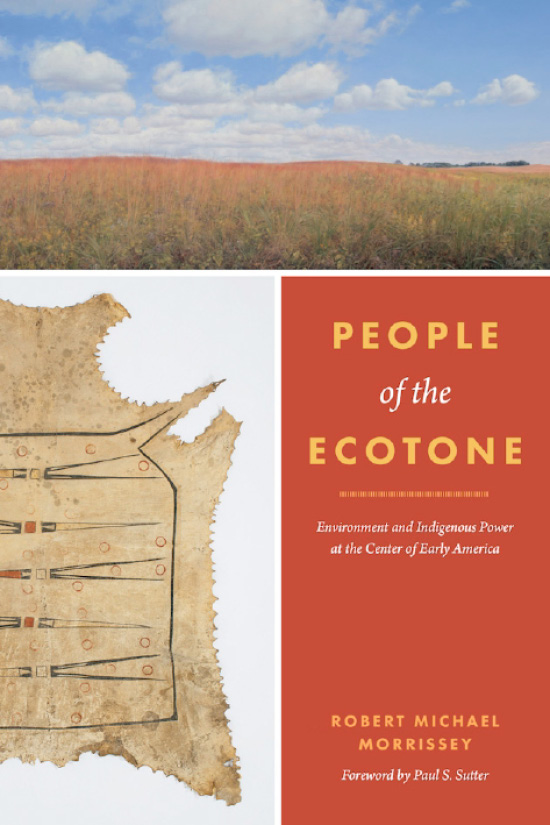
Photo courtesy of the University of Washington Press
The ecology of the region today bears little resemblance to what it was like prior to full-on European settlement in the first half of the nineteenth century, let alone in the late seventeenth century, and Morrissey is to be commended for his efforts to help us imagine how it was. He devotes considerable attention to the bison, which at times were so numerous in places like the Illinois Valley that Native hunters, pursuing them on foot, took them by the hundreds. Competition among the various tribes in the region for game resources pre-dated the arrival of Europeans and underlay cycles of warfare, which Morrissey describes in detail, but gained added significance in the context of colonial trade. By de-centering European colonialism in telling the story, Morrissey allows Indigenous politics, which followed its own logic and generated its own complex adaptive behaviors, to come into focus as an independent force and not merely a reaction to the colonial presence.
Morrissey’s book is so rich in historical detail that no short summary can hope to do it justice. Suffice it to say here that the core of the story is the evolving interactions among the many Indigenous populations in the ecotone, with special attention to the fraught relationship between the Meskwaki and the Illinois, exacerbated by the arrival of the French and the endless jockeying for economic and political advantage among the various parties. The bloody climax of these conflicts were the so-called “Fox Wars” fought by the Meskwaki (Fox) and their sometime Indian allies on one side and the Illinois and French and their allies on the other. The wars spanned decades, and at one point the French declared what can only be characterized as a policy of extirmination against the Meskwaki. Over time, warfare and disease badly weakened both the Illinois and the Meskwaki, and the Meskwaki very nearly were extirminated in the battle of Arrowsmith (Illinois) in 1730. That they have not only survived until the present but today own over 8,000 acres of land in east central Iowa testifies to their remarkable resilience. The French exited the region in 1763 as a result of the Treaty of Paris that ended the French and Indian/Seven Years’ War. Morrissey skillfully ties these historical events to ecology in ways both surprising and illuminating.
Repairing Iowa’s Degraded Ecology
Cornelia Mutel’s introduction to the volume of essays she edited about Iowa’s ecology, Tending Iowa’s Land: Pathways to a Sustainable Future, includes the following simple statement: “Iowa has major environmental problems” (p. xi). Whether we consider Iowa’s soil, water, air, or wildlife - the four sections into which Mutel, retired senior science writer at IIHR Hydroscience & Engineering at the University of Iowa, has arranged the book’s sixteen scientific chapters and twelve short personal stories interspersed among them - the basic picture is one of degradation, often severe. It has been said that Iowa is the most transformed state in the nation from its pre-European settlement character. That transformation, due mostly to agriculture, has produced enormous quantities of human food, animal feed, and more recently engine fuel for our various machines, as well as prosperity, but at the expense of the natural environment.
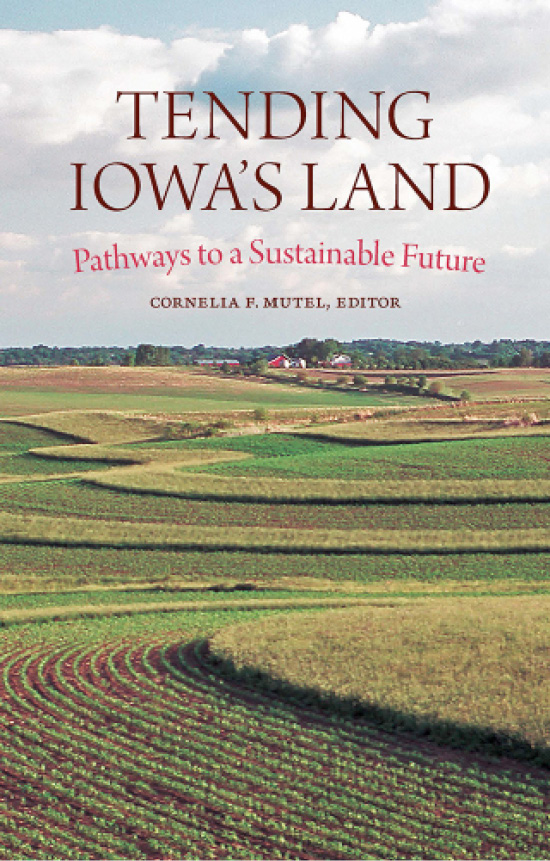
Photo courtesy of the University of Iowa Press
Many of the thirty authors in Mutel’s collection were born in Iowa, and nearly all were born in the Midwest. A frequent theme in their essays is the contrast between the natural environment they experienced in their youth and what they see today in terms of soil quality, water quality, air quality, and biodiversity. The sum and substance of the changes are what contributor Larry Weber calls “a landscape badly out of balance” (p.122). Some of the authors do note environmental degradation that occurred before the 1940s, particularly in the areas of soil quality and biodiversity, and others note improvements in some specific measures (for example, control of waste water and point source pollution, the return of some animal species that had been extirpated from the state, and the generation of energy from renewable sources), but to most of the authors the situation has become grim, even dire, in the brief span of a single lifetime.
What are the reasons for this? Most of the authors blame industrial agriculture for the state’s environmental woes and highlight various specific practices that degrade soil, water, air, and biodiversity. Another factor, touched on by nearly every contributor, is the ominous matter of climate change, which clearly is no longer a prospect but a present and growing reality that contributes to all of Iowa’s environmental problems. Contributor William J. Gutowski, Jr., drives the point home: “These impacts should be viewed not individually, piecemeal, but collectively, as forces that are reshaping andultimately endangering Iowa’s web of interacting natural, human, and societal systems” (p. 151). Climate change has the longest list of page references in the book’s index; agriculture is second.
A related question, touched on by some of the authors, is why more has not been done to address the problems. Reasons include ignorance, due to an overall decline in the amount of interaction Iowans have with the natural world, and a lack of will, including political will. To her credit, Mutel understands that negativity and pessimism are poor foundations for positive action, and she asked her contributors to look for signs of hope, and generally they do. One of these signs, touched on by many of the authors, are the many public and private entities and organizations in Iowa that are working to reverse the damage: the Department of Natural Resources, the Neal Smith National Wildlife Refuge, the Iowa Flood Center, ReLeaf Cedar Rapids, Project AWARE, the Iowa Geological Survey, the Iowa Wildlife Center, and others too numerous to mention. Concerned readers will take heart from their efforts. But, as many of the authors say, individual residents of the state must also step up to address the problems through their words, actions, voting, and economic support of the above organizations. Collectively and individually, we can, and must, be willing to pay the price ($10 billion, contributor Larry Weber estimates; p. 125) to stop Iowa’s decline into becoming an ecological sacrifice zone and an unhealthy place to live. It comes down to the choices we make.
Iowa at A Crossroads: Which Path Will We Choose?
There is an obvious resonance between Cornelia Mutel’s book title (see above) and the title of Charles Connerly’s Green, Fair, and Prosperous: Paths to a Sustainable Iowa. Connerly is clearly cognizant of Iowa’s environmental problems reviewed by the contributors to Mutel’s volume, and he spends time discussing the impact of agriculture on Iowa’s soil, water, and air. However, he contextualizes Iowa’s environmental problems within a broader sustainability framework that includes economic sustainability and social sustainability as well, the three together often referred to as the triple bottom line of sustainability. To thrive, a society must achieve sustainability in all three dimensions, just as a three-legged stool needs all three legs to stand. It must be “green, fair, and prosperous.” Connerly contends that Iowa is “far away” (p. xxiii) on all counts from being that.
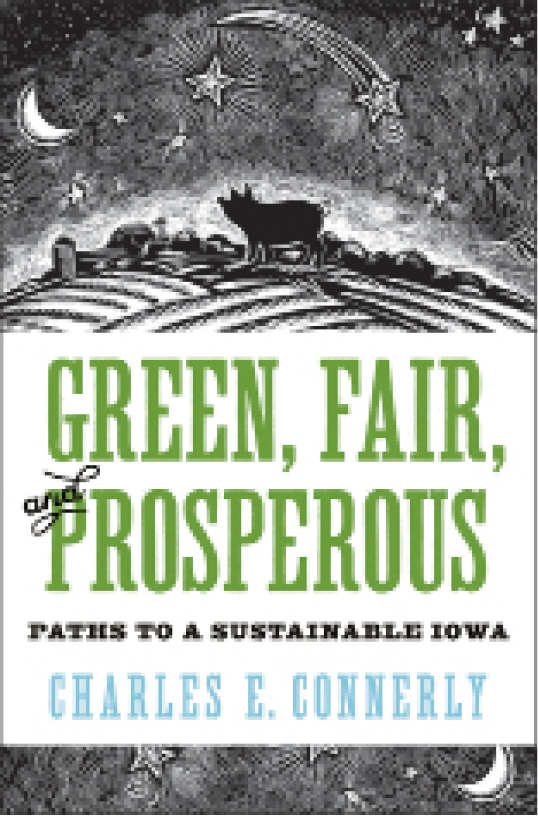
Photo courtesy of the University of Iowa Press
Connerly, recently retired as professor and director of the University of Iowa’s School of Urban and Regional Planning, brings an historical perspective to his analysis of where Iowa stands today in terms of the triple bottom line. Aspects of the drift toward unsustainability began even before Iowa achieved statehood in 1846. Illinois blacksmith John Deere’s breaking plow, invented in 1836, enabled farmers to “break the prairie” and begin the use of unsustainable agricultural practices - later supplemented by agrichemicals – that have continued to degrade Iowa’s soil, water, and air quality. Iowa fares no better in terms of equity. In 1839, the Iowa territorial legislature passed laws “restricting the civil liberties and civil rights of black residents” (p. 98), and in 1845 federal treaties removed the Meskwaki, Sauk, and other indigenous people from the territory that became Iowa. Iowa became a predominantly white state by design, and as Connerly shows these early restrictions on people of color have essentially continued, with limited improvements, to the present, including the addition of poorly paid immigrants to the agriculture-related workforce. Iowa lags other states, he argues, in various measures of social sustainability. In the economic realm, the arrival of railroads, the rise of the meatpacking and other agribusiness industries, the growing reliance on ever-larger farm equipment, the patenting of seed corn, the introduction of genetically-engineered crops, the breaking of labor unions in the meatpacking and farm implement industries, the shift to confined animal feeding operations (CAFOs), and the turn to biofuels, especially ethanol, led to prosperity, but mostly for corporations. As a result, the wealth gap is widening, many of Iowa’s small towns are dying, and the economy looks increasingly unsustainable.
Connerly’s thesis, anticipating many of the authors in Mutel’s book, is that Iowa (and, for that matter, much of the prairie region) is at a crossroads. If the state continues to go in the direction it has generally been going for the last half-century or more, it will draw ever farther away from being green, fair, and prosperous. Or Iowans can choose to go in a different direction - and in his final chapter Connerly offers a dozen specific, practical suggestions about what that other direction could look like - that moves the state toward environmental, economic, and social sustainability.
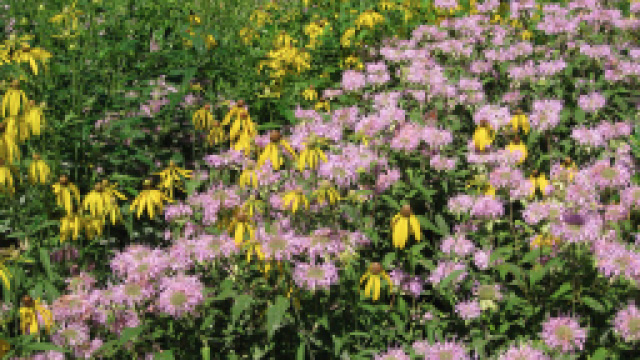
Gray-headed coneflowers and bee balm. Photo by Jon Andelson


